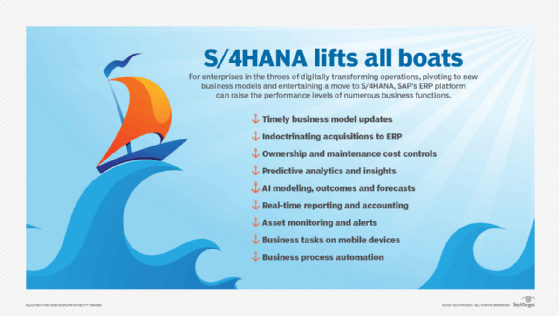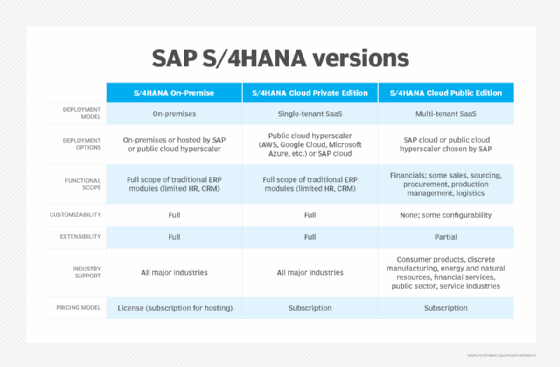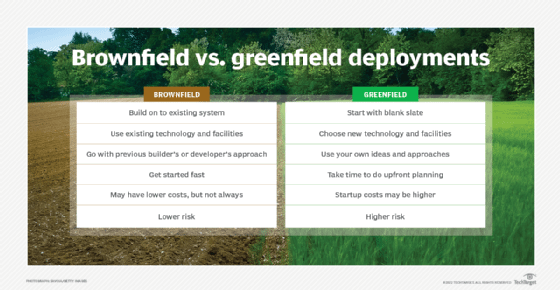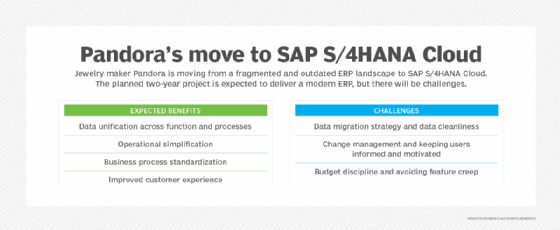SAP S/4HANA migration: A definitive guide
Moving a business to S/4HANA comes with major risks, yet it is also a real opportunity for digital transformation. Here's the information and best practices to ensure success.
S/4HANA is the latest generation of SAP ERP in a 53-year history that has produced just five generations. As the flagship, S/4HANA is the focus of most of SAP's development efforts in cloud architecture, AI, analytics and sustainability and the vehicle intended to carry SAP customers into the future -- at least for the intermediate term.
There are lots of good reasons to move to SAP S/4HANA. But perhaps the biggest reason is the Dec. 31, 2027 deadline that SAP has given customers to move off their old SAP ERP to S/4HANA.
Numerous surveys indicate most SAP customers are convinced enough of the benefits of an SAP S/4HANA migration to be actively considering or planning one. For its part, SAP claims double-digit annual growth rates for S/4HANA adoption and revenue.
But research from Gartner reveals the push for S/4HANA migration isn't going so well. According to second-quarter 2024 figures, 63% of owners of S/4HANA's predecessor, SAP ERP Central Component (SAP ECC), have not licensed S/4HANA. As each month passes, more SAP customers risk missing the deadline if they don't act soon.
Their reluctance is understandable. The hurdles are daunting. They include a huge commitment of time and resources; significant technical, operational and financial risks; and a general fear of exchanging the familiar for the unknown.
An S/4HANA migration cannot be undertaken without a clear-eyed view of the entire process. Reading this overview will help you understand the steps, benefits and challenges of this technological leap before deciding whether to make the move. Click on the links for detailed explanations of key terms and best practices.
Why migrate to SAP S/4HANA?
Before tackling the whys of S/4HANA migration, it's important to define migration and the focus of this guide. It is not about buying your first ERP. The term migration usually refers to the process of completely replacing an existing ERP system and moving data and business processes to the new platform or, alternatively, keeping the old ERP and only moving certain things. Therefore, the questions in this guide center around reasons to migrate, whether to do it and how. Those questions divide further into practical issues of timing, which version of S/4HANA to move to, deployment options (cloud or on-premises), whether to undertake a whole or partial migration and how to prepare the organization for massive change.
When they were interviewed three years ago, practice leaders at major consulting firms that are also SAP ERP implementation partners -- Deloitte, EY and IBM -- said clients at the time were typically moving to S/4HANA because their legacy systems were no longer sustainable or because they wanted a more current ERP system that gave them access to leading-edge technologies.
The technological upgrade from S/4HANA is, no doubt, substantial and remains a major reason to adopt the platform. SAP calls S/4HANA a complete rewrite of the previous generation, Business Suite and its digital core, ECC -- to the tune of 400 million lines of program code -- designed to run exclusively on SAP's HANA in-memory database. HANA makes S/4HANA run faster than Business Suite, which usually runs on other vendors' databases, such as Oracle or IBM Db2.
S/4HANA has a more modern UI based on the SAP Fiori UX. It's also SAP's near-exclusive platform for delivering new technologies, such as AI, machine learning, advanced analytics and IoT, as well as tools to foster environmental sustainability.
Notwithstanding all that, the impending 2027 deadline has now become the major reason to move to S/4HANA. That's the date SAP plans to end support of Business Suite and ECC, along with their predecessor, R/3. Customers can extend maintenance for three years for a 2% premium, but only if they commit to buying S/4HANA.
In 2023, SAP announced a further incentive that is both carrot and stick. It would only make the latest AI and sustainability advances available on S/4HANA Cloud through its Rise with SAP implementation program, cutting even the on-premises S/4HANA out of the innovation pipeline. Many customers were outraged, especially those that had only recently moved to on-premises S/4HANA.
What are the benefits of an S/4HANA migration?
The list of potential SAP S/4HANA benefits is extensive. Most derive from S/4HANA's roots in HANA, which speeds up queries and analytics on potentially large pools of internal and external data. The common theme is speed.
The other big batch of potential benefits is enabled by the SaaS architecture of SAP S/4HANA Cloud and close integration with the SAP Business Network and other cloud-only technologies -- especially AI.
Other important advantages of both the cloud and on-premises versions of S/4HANA include the following:
- Real-time analytics on consolidated data.
- Speedier period-end financial closings.
- More accurate forecasting.
- Simpler UI.
- Process automation.
- Easier-to-update business models.
The cloud versions add two key capabilities: access to the latest technology, including AI, chatbots and IoT, and quarterly or semiannual updates.

What are common migration challenges?
Surveys and case studies of the past five years have shown that the S/4HANA move often takes longer, costs more and requires more training than many people expect. Other challenges include change management, dealing with customizations, integrating legacy applications with S/4HANA and educating people about its benefits.
One of the toughest challenges is figuring out whether the platform has the ERP functions the business needs. The task involves closely examining the features of the S/4HANA modules that align with the business -- say, procurement, supply chain management and accounting -- and seeing if specific actions and workflows of the existing ERP can be mapped to S/4HANA.
Organizations also typically struggle with integrating systems and moving vast amounts of data. Legacy IT landscapes can be extremely complex, with a mix of on-premises, SaaS and private cloud applications that must communicate and share data with the new ERP. In fact, three-quarters of respondents to a 2024 survey for the UK & Ireland SAP User Group named data management as the top S/4HANA migration challenge. Similar percentages cited data duplication and siloing as challenges, along with a lack of data skills.
With S/4HANA, SAP started moving away from its longstanding model of ERP as a sprawling, monolithic system that does almost everything a business needs. S/4HANA depends on other SAP or third-party applications for key business functions that used to be included, such as HR and CRM, so it's important to establish an integration layer and common data model to avoid isolating S/4HANA from other applications.
SAP users also often struggle to move forward without the customizations they've grown accustomed to in their legacy ERP. The Business Technology Platform (BTP) is the SAP-sanctioned preferred means of extending S/4HANA to gain a measure of customization. BTP is the collection of cloud, analytics, AI, machine learning and integration tools and platforms that give S/4HANA much of its mojo.
BTP takes significant development resources, which means hiring or retraining staff for BTP skills or using a consultant. In its 2024 report evaluating cloud ERP for service-centric enterprises, Gartner cautioned that companies might find it challenging to understand the impact of AI and BTP data and messaging needs on S/4HANA Cloud's total cost of ownership.
Choosing an S/4HANA deployment option
There are now just three S/4HANA versions, as SAP has worked in recent years to cut the deployment choices roughly by half.
In the decade since S/4HANA's introduction, the on-premises version has gained enough ERP modules to bring its capabilities nearly up to par with those of Business Suite. S/4HANA now has modules for all the major business functions, including finance, sales and distribution, production planning, sourcing and procurement, and supply chain management, among others.
Despite the near parity, the remaining differences between on-premises Business Suite and on-premises S/4HANA could be critical to some enterprises. Often, the decision comes down to whether or not to exchange longstanding customizations for the standardized processes, best practices, real-time analytics and leading-edge technology that S/4HANA offers.
Besides on-premises deployment, there are two S/4HANA Cloud options:
- Public Edition. This S/4HANA Cloud version is more streamlined and generic because it follows the multi-tenant SaaS model, which means different customers share the same instance of the software, so it must satisfy a broader range of needs. SAP delivers S/4HANA Cloud Public Edition from its own cloud or a public cloud of its choosing.
- Private Edition. This S/4HANA Cloud version runs in single-tenant SaaS, so each customer gets its own instance of the software and has more control over it, including some ability to customize and decide when to upgrade. It provides all the business functions of on-premises S/4HANA, in contrast to the more limited Public Edition, and it runs on SAP-operated infrastructure at a public cloud provider, such as AWS, Google Cloud or Microsoft Azure, or on SAP's cloud.
There are also deployment decisions to make for the on-premises version. Besides running S/4HANA in an on-premises data center, the choices include hosting on SAP's managed, private-cloud service or a public cloud hyperscaler. Outsourcing relieves IT of having to manage the infrastructure but retains a measure of control.

SAP S/4HANA migration approaches
Organizations moving their ERP to S/4HANA can choose from three main approaches that vary by how complete the migration process is.
Greenfield. A greenfield deployment is a fresh start: a completely new ERP system often running on new data center or cloud infrastructure. In some cases, it is an organization's very first ERP, but it can also involve a move from another vendor's ERP or an older SAP system. One significant drawback is the work required to translate existing business processes into S/4HANA's way of doing things. Moving data from the old ERP and training employees on the new system are the other major challenges. But this kind of wholesale move is usually the best way to get all of S/4HANA's advantages, such as predictive analytics, AI modeling, process automation and real-time reporting.
Brownfield. Brownfield is the generic IT term for deploying new software systems while continuing to use some legacy components. A common approach in an S/4HANA migration is to start with the financial module, SAP S/4HANA Finance, and its integration platform, Central Finance, and put off the move to other modules. Partial migration is feasible because accounting is a classic back-end process that doesn't change much. Organizations can switch their accounting to a new ERP system without disrupting the business, then move on to customer-facing front-end processes, such as logistics and CRM.
The S/4HANA Finance-Central Finance move is just one type of brownfield approach. The SAP greenfield vs. brownfield debate can help to frame the S/4HANA migration discussion.

Hybrid (bluefield). A middle ground between greenfield and brownfield, this approach is meant to enable organizations to minimize disruptions from implementing S/4HANA while still getting its advantages. The old ERP is kept, and only the most critical data gets moved.
SAP S/4HANA migration services
SAP aggressively promotes two major programs to help customers with their S/4HANA migrations.
Rise with SAP
Billed as "business transformation as a service," Rise with SAP is a bundle of products and services SAP offers to help large enterprises migrate to S/4HANA Cloud Private Edition and the broader SAP cloud ecosystem on which it depends, which includes the Ariba procurement network and Concur Travel & Expense, among others.
Rise comes with a methodology that includes a structured framework, roadmap, software tools and consulting from SAP experts. It also provides access to Build, SAP's low-code/no-code application development platform.
Many of SAP's longstanding system integration and implementation partners handle the consulting, development and integration in Rise with SAP, among them Capgemini, Deloitte, EY, IBM and PwC. It's all done under a single contract meant to simplify administration and coordination of the various platforms and vendors.
The consulting partners have their own methodologies and tools for SAP S/4HANA migration outside of Rise with SAP. They can automate testing of ERP software code to determine what can and should move to S/4HANA. They also offer prebuilt industry configurations of S/4HANA that can help S/4HANA adopters put their legacy ERPs behind them and facilitate moving to the next-generation ERP.

Grow with SAP
This service is designed to get SMBs that have opted for a greenfield deployment up and running quickly on S/4HANA Cloud Public Edition. It comes with preconfigured industry best practices, embedded AI and access to Build. Grow targets companies that can use software out of the box. It also works well in two-tier ERP, where a company already runs ECC -- typically in headquarters -- and needs to extend its SAP environment quickly to a new market or business unit.
Rise and Grow both rely on BTP for S/4HANA's extensibility. To solidify the process and ease the transition to the cloud, in the early 2020s SAP began pushing the Clean Core methodology.
With Clean Core, software extensions are kept separate from S/4HANA. They instead access SAP software objects through well-defined BTP interfaces so that updates can't break the application. Extensions and customizations to on-premises ECC are tangled up with the application itself, which is why it's hard to migrate customized ERP systems to the cloud.
The core in Clean Core refers to the processes, data and integration that are integral to the operation of S/4HANA itself. Keeping the core clean means not modifying it in any way, eliminating extensions that duplicate functions already in S/4HANA, and writing interfaces that only use APIs officially released by SAP or tools in the BTP and the SAP Integration Suite.
Alternatives to S/4HANA migration
S/4HANA isn't the only option for organizations with legacy SAP ERP systems that have become outmoded and cost-prohibitive or companies that are anxious about the 2027 deadline. There are other ERP products to choose from, along with ways to extend a system's life.
Business ByDesign
If adopting multi-tenant SaaS ERP is the goal, or if S/4HANA seems like a risky bet, SAP offers another option: Business ByDesign. It's used by more than 16,000 midmarket customers – those with annual revenue under $1 billion and fewer than 1,000 employees, according to SAP, which continues to update the product and publish a roadmap of planned improvements. Carefully comparing SAP Business ByDesign vs. S/4HANA before committing to the latter, which is more complex and expensive but also has more capabilities, can save time and money.
Business One
SAP sells another SMB-oriented ERP whose history at SAP dates all the way back to 2002, when SAP bought an already six-year-old on-premises ERP and renamed it Business One. Pitched as a more affordable, entry-level choice for small businesses in the lower midmarket, it's the top-selling SAP ERP product, with 80,000 customers, according to the SAP. Business One is also customizable and can be hosted in the cloud.
Regardless, it's hard to see why SMBs hoping to grow would migrate to Business One from another SAP on-premises system or from Business ByDesign with its multi-tenant SaaS scalability and easier access to the cloud-based technologies. Gartner recommends watching the roadmaps for both products closely, however, as SAP has signaled it will no longer augment them with the newest technologies so it can focus innovation on S/4HANA.
Other ERP vendors
SAP S/4HANA alternatives are worth a look if buying from SAP is not a priority. Oracle Fusion Cloud ERP, the flagship of archrival Oracle, is among the leaders in full-featured SaaS ERP; Gartner ranks it slightly ahead of S/4HANA Cloud. Oracle's other products include SaaS-based NetSuite, which targets SMBs, and the on-premises JD Edwards, which has a large installed base in manufacturing and remains a viable option.
Among other SaaS leaders, Workday makes it onto many buyers' shortlists, but it focuses more narrowly on HR and financials and appeals more to service-oriented companies. For product-oriented companies, Microsoft Dynamics 365, with its comprehensive manufacturing and supply chain features, is a better cloud alternative.
Other prominent brands, some of which continue to update on-premises manufacturing and supply chain suites that rival SAP and Oracle products -- albeit while directing most of their new investment to SaaS -- include Epicor, IFS, Infor and QAD.
SAP extended and third-party maintenance
ECC owners can buy more time for their system through the end of 2030 with SAP extended maintenance if they're willing to pay the 2% premium and commit to S/4HANA.
Several companies specialize in servicing SAP and Oracle systems after vendor support runs out. Rimini Street and Spinnaker are prominent among those promising to extend the life of SAP ECC and keep it current with technology by helping to write extensions.
Key steps and considerations for a successful S/4HANA migration
The choice of migration method usually comes up in the design phase of planning a strategy and roadmap.
SAP and its consulting partners offer rigorous planning processes for analyzing the factors that determine which migration method is best. It's often called phase zero and aligns with the early stages of the Activate methodology that SAP offers to Rise and Grow customers. The terminology varies, but here are the key steps:
- Evaluate the current system. Also called discovery or readiness assessment, this involves assessing the existing ERP system, its data and the business processes affected, often with statistics to quantify their efficiency. SAP's Readiness Check tool can speed up the process. Licensing and maintenance costs are also considered, and users can share their pain points. IT takes an inventory of custom code and analyzes master data.
- Review the architecture. Here, users determine how existing ERP modules and business processes map to the available S/4HANA modules and deployment options, and then decide which ones to leave behind.
- Analyze the future state. In this step, customers can envision what the new ERP should do based on requirements gathered from users, department heads, executives and other stakeholders. They can also try to quantify the benefits, such as cost savings from consolidating ERP systems or launching an e-commerce business. The information feeds into the ERP business case, which is usually one of the next steps.
Much of the initial evaluation phase focuses on data. The first major step is to analyze the data in the current ERP and categorize it as hot (frequently used data that should be stored in S/4HANA's in-memory database and migrated first); warm (less frequently used but important data that can move to S/4HANA disk storage); and cold (historical or rarely used data that can be archived). Next comes data cleansing to fix errors in the data, such as duplication and nonstandard formatting.
SAP and its consulting partners make data management a central focus of their S/4HANA migration services and offer assistance, tools and methodologies expressly for the purpose.
Choosing an S/4HANA implementation partner
Dozens of implementation partners have long histories with SAP that predate S/4HANA by decades. Choosing the right one requires due diligence. Here's the consensus advice from industry analysts and consultants:
- Look for a strong selection of deployment methodologies, automated testing and data migration tools.
- Ask how many people will be assigned to the project and which ones will work exclusively for you.
- Check for SAP S/4HANA certification, an indicator of actual experience with S/4HANA implementations.
- Talk to references with similar projects, ideally in the same industry.
- Ask what kind of support is available after the new system goes live and whether it costs extra.
- Insist on guarantees that the project won't be late or go over budget.
Close collaboration between your internal project team, SAP and its partner, all working from a detailed roadmap, can go a long way toward ensuring a successful S/4HANA migration.







